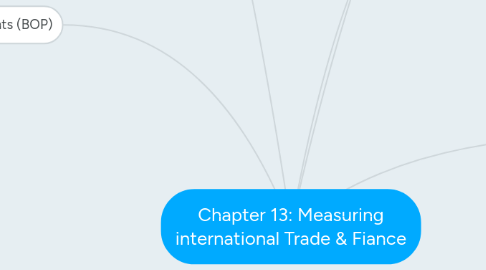
1. Balance of Payments (BOP)
1.1. It is a comprehensive record of international receipts and international payments between the residents & government of a country and the rest of the world.
1.1.1. Current Account
1.1.1.1. Visible Trade Account aka "Balance of trade"
1.1.1.1.1. This records M and X of physical goods from "commodities" to "manufactured goods"
1.1.1.1.2. A trade surplus is when the value of visible exports exceeds the value of visible imports.
1.1.1.1.3. A trade deficit is when the value of visible exports is less than the visible imports
1.1.1.2. Invisible Trade (Service) Account
1.1.1.2.1. This records imports and exports of services.
1.1.1.3. Unilateral Transfers
1.1.1.3.1. This records all the gift and remittances (money) sent abroad by local residents to their friends and ralatives abroad.
1.1.2. Capital Account
1.1.2.1. This account records the flow of funds into the country and out of the country and is associated with changes in ownership of assets
1.1.2.1.1. Short term capital involves liquid funds moving among fiancial centres searching for higher interest rates and safety of capital
1.1.2.1.2. Long term capital include both Foreign Direct Investments (FDI) and Portfolio investments
1.1.3. Financial Account
1.1.3.1. This account represents transactions in the government's reserves in the form of foreign currencies, gold and Special Drawing Rights (SDRs)
1.2. The sum of the current, capital and official financing accounts must be zero
2. Factors affecting the Balance of Payments
2.1. Domestic income level
2.1.1. Sustained economic growth and rise and income encourages demand for locally produced goods as well as imports. Import spending rises due to higher purchasing power The volume of exports falls and exports earning fall → Deficit in BOT
2.2. Income levels in export destinations
2.2.1. The BOP would be adversely affected if the level of income in the countries it exports to fall
2.3. Country's stage of development
2.3.1. A developing country may have a trade deficit because it needs to import the necessity raw materials and capital equipment for development purposes.
2.4. Long term investment prospects
2.4.1. Good investment prospects due to the country's political economic stability could bring about net capital inflows and a capital account surplus.
2.5. The rate of interest
2.5.1. High or rising interest rates in a country would induce the inflow of short term capital outflow
2.6. Change in the prices of imports and exports (TOT)
2.7. Expected change in the country's currency exchange rate
2.7.1. Any expected depreciation or devaluation of the local currency could lead to capital outflows and a capital account deficit as foreigners pull out their funds and vice versa.
2.8. Government Policy
2.8.1. Policies such as subsidies, to encourage the production of more import substitutes would lead to a fall in imports as domestic goods become relatively cheaper to imports. This could in turn lead to a balance of trade or perhaps a balance of payment surplus.
3. International trade is the exchange of goods or service between countries - An import to Singapore is the Singapore purchase of a good or service made overseas. - An export from Singapore is the sale of a Singapore - made goods or service overseas.
4. Reasons Why Countries Trade
4.1. Supply
4.1.1. Differences in Factor Endowment
4.1.1.1. Different countries possess different quantities and qualities of the various productive resources. - Population density - Labour skills - Climate - Raw materials - Capital equipment - Technology
4.1.2. International Immobility of FOP
4.1.2.1. Land and climate are totally immobile between countries, but labour mobility may be limited due to language, cultural and religious barriers and immigration restriction.
4.1.3. Differences in Factor Proportions
4.2. Demand
4.2.1. Product Differentiation
4.2.1.1. Different goods need different factor combinations. (The cost of producing the same good in different countries vary. Rice production needs more land, so it is produced in countries with abundant land. )
4.2.1.2. Consumers may prefer different brands and different qualities of products. Different consumption patterns and cause price differences in the same goods and hence provide the basis of trade.
4.2.2. Stage of Economic Development
4.2.2.1. In a less developed country, it would probably need to import more consumer products as the country's own productive capacity is low. (Basic necessities )
4.2.2.2. In a developing economy which is expending its productive capacity, it would require more capital good. such as building materials, machinery and tools.
5. Terms of trade is the rate of exchange of one good or service for another when two countries trade with each other.
5.1. Terms of Trade index = (Export price index/Import price index) x 100
5.2. Factors affecting terms of trade
5.2.1. A fall in DD for a country's exports and hence the price of exports (Px).
5.2.2. An increase in the supply of major exports which results in a fall in their price (Px)
